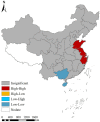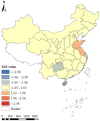Temporal and spatial characterization of myopia in China
- PMID: 36052009
- PMCID: PMC9424616
- DOI: 10.3389/fpubh.2022.896926
Temporal and spatial characterization of myopia in China
Abstract
Purpose: The aim of this study was to characterize the temporal and spatial distribution of myopia among students aged 7-18 years, by analyzing the aggregation area and providing the basis for the prevention and control of myopia in China.
Methods: A database for the spatial analysis of myopia in China during 1995-2014 was established using ArcGIS10.0 software as a platform for data management and presentation. A spatial autocorrelation analysis of myopia was undertaken, and a temporal and spatial scan analysis was performed using SaTScan9.5 software.
Results: Our data demonstrated that the prevalence of myopia in China in 1995, 2000, 2005, 2010, and 2014 was 35.9, 41.5, 48.7, 57.3, and 57.1%, respectively, thus indicating a gradual upward trend. The prevalence of myopia was analyzed in various provinces (municipalities and autonomous regions), and the highest was found in Jiangsu Province, with an average Moran's I index of 0.244295 in China (P ≤ 0.05). According to the local Moran's I autocorrelation analysis, there was a spatial aggregation of myopia prevalence among students in the entire country, with Shandong, Jiangsu, Anhui, and Shanghai being classified as high-high aggregation areas, while Hainan and Guangxi were classified as low-low aggregation areas. In addition, the Getis-Ord General G results of the global hotspot analysis showed a countrywide myopia prevalence index of 0.035020 and a Z score of 1.7959 (P = 0.07251). Because the myopia prevalence correlation difference was not statistically significant, there were no "positive hotspots" or "negative hotspots." The local hotspot analysis shows that Shandong and Jiangsu belong to high-value aggregation areas, while Hainan and Guizhou belong to low-value aggregation areas. Further analysis using time-space scanning showed 15 aggregation regions in five stages, with four aggregation regions having statistically significant differences (P ≤ 0.05). However, the aggregation range has changed over time. Overall, from 1995 to 2014, the aggregation areas for the myopia prevalence in Chinese students have shifted from the northwest, north, and northeast regions to the southeast regions.
Conclusion: Our data demonstrate that, from 1995 to 2014, the prevalence of myopia increased in students aged 7-18 years in China. In addition, the prevalence of myopia is randomly distributed in various provinces (municipalities and autonomous regions) and exhibits spatial aggregation. Also, the gathering area is gradually shifting to the southeast, with the existence of high-risk areas. It is, therefore, necessary to focus on this area and undertake targeted prevention and control measures.
Keywords: China; geographic information system; myopia; spatial autocorrelation analysis; spatiotemporal analysis.
Copyright © 2022 Shi, Gao, Leng and Guo.
Conflict of interest statement
The authors declare that the research was conducted in the absence of any commercial or financial relationships that could be construed as a potential conflict of interest.
Figures




Similar articles
-
[Temporal-spatial distribution of tuberculosis in China, 2004-2016].Zhonghua Liu Xing Bing Xue Za Zhi. 2020 Apr 10;41(4):526-531. doi: 10.3760/cma.j.cn112338-20190614-00441. Zhonghua Liu Xing Bing Xue Za Zhi. 2020. PMID: 32344476 Chinese.
-
Temporal and Spatial Characteristics of Cataract Surgery Rates in China.Risk Manag Healthc Policy. 2021 Aug 25;14:3551-3561. doi: 10.2147/RMHP.S317547. eCollection 2021. Risk Manag Healthc Policy. 2021. PMID: 34475788 Free PMC article.
-
Analysis of spatial-temporal dynamic distribution and related factors of tuberculosis in China from 2008 to 2018.Sci Rep. 2023 Mar 27;13(1):4974. doi: 10.1038/s41598-023-31430-0. Sci Rep. 2023. PMID: 36973322 Free PMC article.
-
[Epidemiology of high myopia among children and adolescents in China].Zhonghua Yan Ke Za Zhi. 2023 Feb 11;59(2):138-145. doi: 10.3760/cma.j.cn112142-20220313-00105. Zhonghua Yan Ke Za Zhi. 2023. PMID: 36740444 Review. Chinese.
-
The Current and Future Landscape of the Childhood Myopia Epidemic in China-A Review.Ophthalmol Ther. 2024 Apr;13(4):883-894. doi: 10.1007/s40123-024-00887-1. Epub 2024 Feb 1. Ophthalmol Ther. 2024. PMID: 38300487 Free PMC article. Review.
Cited by
-
Epidemiological variations and trends in glaucoma burden in the Belt and Road countries.BMC Ophthalmol. 2024 Apr 25;24(1):195. doi: 10.1186/s12886-024-03464-z. BMC Ophthalmol. 2024. PMID: 38664615 Free PMC article.
-
A survey of public eye-care behavior and myopia education.Front Public Health. 2025 Feb 18;13:1518956. doi: 10.3389/fpubh.2025.1518956. eCollection 2025. Front Public Health. 2025. PMID: 40046115 Free PMC article.
-
Regional disparities in the prevalence and correlated factors of myopia in children and adolescents in Gansu, China.Front Med (Lausanne). 2024 Aug 1;11:1375080. doi: 10.3389/fmed.2024.1375080. eCollection 2024. Front Med (Lausanne). 2024. PMID: 39149607 Free PMC article.
-
Analysis of the spatio-temporal evolutionary characteristics of myopia among students aged 7-18 years in China: based on panel data analysis.Sci Rep. 2024 Nov 26;14(1):29343. doi: 10.1038/s41598-024-80990-2. Sci Rep. 2024. PMID: 39592863 Free PMC article.
-
Long-term observation of the in vivo safety of a new design of phakic refractive lens.BMC Ophthalmol. 2025 Jan 7;25(1):10. doi: 10.1186/s12886-024-03803-0. BMC Ophthalmol. 2025. PMID: 39773390 Free PMC article.
References
-
- Chen S. The Overall Myopia Rate of Children and Adolescents in China is 52.7% in 2020. Beijing: China Women's Daily; (2021).
Publication types
MeSH terms
LinkOut - more resources
Full Text Sources

